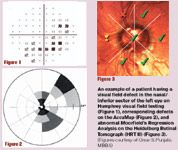Article
Objective tests of glaucomatous changes show good diagnostic agreement
Las Vegas-Results of a cross-sectional study demonstrate there is good agreement (~85%) between the evaluation of the optic nerve head structure using the Heidelberg Retinal Tomograph (HRT II, Heidelberg Engineering) and results of multifocal visual evoked potential testing (mfVEP; AccuMap, ObjectiVision, Sydney, Australia) in identifying normal and glaucomatous eyes as well as statistically significant topographic associations between many HRT parameters and the amplitudes of mfVEP waves on the corresponding opposite hemisphere, reported Omar S. Punjabi, MBBS, at the annual meeting of the American Academy of Ophthalmology.

"The findings from this study confirm the relationship between optic nerve structure and visual function in open-angle glaucoma using two objective tests," he told attendees. "However, the fact that there were striking examples in some patients of poor inter-test correspondence underscores the importance of assessing both structure and function in glaucoma diagnosis and monitoring. Relying on structure or function evaluation alone may fail to identify the underlying disease process in an appreciable proportion of patients."
Dr. Punjabi conducted the study as a research fellow in the Department of Ophthalmology, University of California, San Francisco, in collaboration with Shan Lin, MD, and Robert Stamper, MD. Currently, Dr. Punjabi is a research fellow at Bascom Palmer Eye Institute, University of Miami, Miami.

To be eligible for participation, individuals had to have good visual acuity (better than 20/40), refraction better than ±6 D, and no history of other ocular diseases that could affect the visual field or optic nerve head structure.
The participants underwent both HRT and mfVEP testing within a 3-month interval. Each subject had both eyes tested, and prespecified criteria were used to exclude poor-quality results from the analysis. For the HRT, only tests with a standard deviation less than 30 µm were included, whereas mfVEP plots had to have noise levels less than 25% and fewer than 10% fixation misses.
The mfVEP responses showed that compared with the normal controls, the glaucoma group had a significantly higher mean AccuMap Severity Index (ASI) and significantly lower mean amplitude. With an ASI value of <20 used as the cut-off for defining within normal limits, the mfVEP offered high sensitivity and specificity for discriminating the glaucoma subjects and normal controls (95.5% and 78.5%, respectively), with glaucoma suspects defined as those with visual field defects.
The results of the HRT were analyzed based on Moorfields regression analysis, and it also offered high sensitivity and specificity (86.5% and 78.5%, respectively) in the study population. Overall, the two tests were in agreement with each other (both normal or both abnormal) in ~85% of eyes in both the normal and control groups.
Newsletter
Don’t miss out—get Ophthalmology Times updates on the latest clinical advancements and expert interviews, straight to your inbox.





